Truckers are a different breed: independent, hard-working, and focused. While in the old days of trucking, navigation happened using road atlases and radios, the new trucking industry relies on dispatchers, third-party logistics software, and GPS systems to get loads to the right place at the right time.
A GPS navigation system is a balance of the new and the old: although it relies on 21st-century tech to get the job done, it maintains the independent spirit of trucking alive by putting knowledge and autonomy into the hands of truckers while they are on the open road.
- Features to Consider in a Truck GPS Navigation System
- Top 10 Best Truck GPS Navigation Systems 2026
- 1. Best Overall Pick: Garmin Dezl 780 LMT-S GPS
- 2. Best Premium Pick: Rand McNally TND 740 IntelliRoute Truck Navigation GPS
- 3. Best Budget Pick: Arova 256M Navigation System
- 4. Best for Long Hauls: Garmin Dezl 580 LMT-S
- 5. Best Refurbished: Rand McNally TND 540 LM
- 6. Best 8-Inch Screen: Rand McNally OverDryve 8 Pro
- 7. Best Large Display: Garmin Dezl OTR1000 GPS Truck Navigator
- 8. Best Map Updates: TomTom Trucker 620
- 9. Best Inexpensive Large Screen: XGody GPS Navigation System
- 10. Best Back-up Unit: OHREX GPS Navigator System
- Guide to Buying the Best Truck GPS Navigation Systems for 2026
- Wrapping Up
If you’re a trucker, your cab is your office, and it’s worth investing in a nice truck GPS navigation system that can help you get your loads in on time, every time. Evaluate the following features when shopping to help pick out the best products.
Screen
From pocket-sized black and white screens to tablet-format GPS readers, screens are the most important physical part of a GPS navigation system. If you’re a long-haul trucker that relies on GPS all day, every day, investing in an HD, glare-free, full-color screen can be well worth the price.
Fleet Management Features
Depending on your status as a contractor, owner operator, employee, or logistics provider, fleet management features can save hundreds of hours, dollars, and gallons of gas each year.
Some truck GPS navigation systems can integrate with third-party logistics software or create an interlinked network that helps dispatchers monitor their fleets and get loads delivered. Fleet service capabilities vary from GPS system to GPS system in terms of power and connectivity, but even the most simple features can profoundly change how truckers operate.
Connectivity
While the most inexpensive units connect to GPS and nothing else, many navigation systems have a full host of features that can be accessed using WiFi and Bluetooth. These features range from simply connecting to your phone, all the way to voice control and inter-device communication with backup cameras, radios, and wireless speaker systems.
Ease of Use
When you’re hauling a load down the highway at 70mph, the last thing you need is a fussy GPS beeping, barking orders, and issuing confusing directions. It’s vital to have a simple, responsive, and easy-to-use touch screen in order to manipulate your navigation system while driving. If it’s hard to use your GPS system, it’s inconvenient at best and dangerous at worst.
Each GPS manufacturer uses a completely different navigation system based on different maps, satellites, and route-building software. Remember the Apple Maps debacle back in 2012? That’s a great example of how things can go wrong, and the results of a poor backend to your GPS navigation are even worse as a truck driver. Stick with reliable GPS providers with good GPS coverage, truck-specific routing, and frequent map updates, or you could end up between a rock and a hard place.
With these features in mind, let’s take a look at some of the best truck GPS navigation systems out there:
| Product | Screen Size | Fleet Management Features | Connectivity | Rating |
|---|---|---|---|---|
| Garmin Dezl 780 LMT-S GPS | 7 Inches | Yes | WiFi, Bluetooth | 5 |
| Rand McNally TND 740 IntelliRoute Truck Navigation GPS | 7 inches | Yes | Bluetooth, WiFi | 4.5 |
| Arova 256M Navigation System | 7 Inches | No | None | 4.5 |
| Garmin Dezl 580 LMT-S | 5 inches | Yes | Bluetooth, WiFi | 4.5 |
| Rand McNally TND 540 LM | 5 inches | No | WiFi | 4.5 |
| Rand McNally OverDryve 8 Pro | 8 inches | Yes | Bluetooth | 4 |
| Garmin Dezl OTR1000 GPS Truck Navigator | 10 inches | Yes | Bluetooth, WiFi | 4 |
| TomTom Trucker 620 | 5 inches, 6 inches | No | Bluetooth, WiFi | 4 |
| XGody GPS Navigation System | 9 inch | No | None | 4 |
| OHREX GPS Navigator System | 7 inches | No | None | 3.5 |
1. Best Overall Pick: Garmin Dezl 780 LMT-S GPS
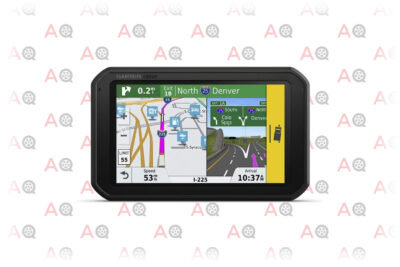
Editor’s Rating:
At a Glance
- Screen Size: 7 Inches
- Fleet Management Features: Yes
- Connectivity: WiFi, Bluetooth
Review
The Garmin Dezl is the Kenworth of navigation systems: durability, ease of use, and comfort all combine to create a product designed solely with truckers in mind. While plenty of owner-operators have made do with sub-par navigation systems in the past, common issues with quality and navigation accuracy are completely resolved with this system.
The one downside comes when it’s time to pay the bill. This isn’t one of those direct-to-consumer sub-$100 units like the OHREX GPS Navigator System. In fact, it’s even more expensive than the already-premium-priced Garmin Dezl 580 LMT-S, its little brother. But in the world of trucking, a reliable unit can make the difference between a missed deadline and a satisfied client for an owner-operator. Besides, as the average trucker drives about 100,000 miles a year, at the end of the day, you’re paying about one cent every 250 miles for the privilege of using the device.
A seven-inch display is tied for second-largest on our list with the Rand McNally TND 740 System, meaning you can enjoy 3D HD graphics and a full-color display in large format.
Watch out for the fact that if you want to use the built-in dash camera feature, you’ll have to carefully set up the GPS so that you can see the screen from the driver’s seat and that the camera can fully see the road ahead—depending on your cabin setup, it can be a little tricky to get right.
Navigation
Garmin is well-known for having some of the best navigation in the game, with a phenomenal truck-centric database loaded with truck-specific advisories and waypoints like truck stops, way stations, bridge-height warnings, and more. Maps are comprehensive and frequently updated with live info, leading to fewer missed turns and more missed traffic jams.
Pros
- Reliable truck-specific system solves common problems of truckers
- 3D HD Graphics on a large-format seven-inch screen
- Incredible navigation accuracy
- Truck specific advisories and waypoints
Cons
- Premium price point
- Can be tricky to set up the dashcam
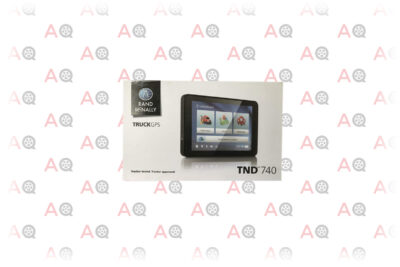
Editor’s Rating:
At a Glance
- Screen Size: 7 inches
- Fleet Management Features: Yes
- Connectivity: Bluetooth, WiFi
Review
Rand McNally’s mid-range GPS device after their flagship Rand McNally Overdrive Pro is a phenomenal, truck-specific, user-friendly device that prioritizes drivers in its approach. Along with the standard GPS features you might see in a car, it also pushes out truck-specific waypoints, real-time weather and traffic updates, and even gas prices.
Sensitive to the needs of truckers, the GPS offers Bluetooth hands-free calling and access to voice assistants via mobile devices. Connect it to your stereo system, and you’re ready to go with automatically included SiriusXM radio stations.
Info and maps are automatically updated, pushed out by Rand McNally’s system. These updates incorporate a high level of detail, with lane guidance in advance of exits, toll cost info, alerts, and even fuel level information that can help you more efficiently plan your stops.
It’s also ELD-ready and can be connected via app or cable to any FMCSA-approved device, making tracking for compliance both intuitive and accurate. Durability is a small concern, as this specific model has a history of some quality-control issues, but Rand McNally has strong customer support and will replace the device if you have any issues.
Navigation
Although this navigation system contains ‘IntelliRoute’ in the title, navigation and routing is far below average for the category and beat out by quite inexpensive products like XGody’s GPS Navigation System for one reason: the lack of non-commercial zones. If you’re in an area or state with non-commercial zones that aren’t fit for semi-trucks, watch out: this GPS could send you down an illegal route.
Pros
- Accurate and user-friendly device with large screen
- Compatible with ELD devices
- High level of truck-specific detail
- Strong customer support
Cons
- Doesn’t keep track of routes with non-commercial zones

Editor’s Rating:
At a Glance
- Screen Size: 7 Inches
- Fleet Management Features: No
- Connectivity: None
Review
While the Arova 256M lacks premium fleet management features, Bluetooth, and WiFi connectivity, it’s still a fantastic pick on the basis of its ridiculously low price. Maps are available for the entirety of the US, Canada, and Mexico. A seven-inch touchscreen displays both 2D and 3D modes of viewing in full color and stores up to 8GB of information.
The touchscreen is quite responsive during use and doesn’t freeze or lock up like other inexpensive devices. Also unique for inexpensive units is the screen, which is designed to be seen even in direct sunlight. And while there isn’t any Bluetooth or WiFi capability, there is an FM transmitter that allows directions to be broadcasted via the speaker.
While the unit itself is fantastic for the price, there are some issues with the GPS system. Where premium units like the Rand McNally TND 740 IntelliRoute pick up a signal practically instantaneously, sometimes it’s a significant wait for this device to sync up with the GPS network.
Navigation
While this GPS has some minor issues related to picking up a signal immediately after turning on the device, accurate navigation and regularly updated maps make up for some of our complaints. Arova pushes out free updates from their website regularly, simply connect to your computer or laptop and download the updates. There aren’t any automatic WiFi updates as with premium devices like the Garmin Dezl 580 LMT-S, but for a fifth of the price, it’s hard to complain too much.
Pros
- 7-inch screen with 2D/3D graphics
- Economical price
- 8GB of map storage
- Frequently updated maps for all of North America
Cons
- Minor delays related to picking up a GPS signal
- No Bluetooth or WiFi capability
4. Best for Long Hauls: Garmin Dezl 580 LMT-S
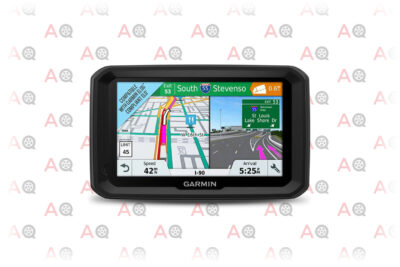
Editor’s Rating:
At a Glance
- Screen Size: 5 inches
- Fleet Management Features: Yes
- Connectivity: Bluetooth, WiFi
Review
The Garmin Dezl 580 is a fundamentally great product: it recognizes the problems of truckers, addresses them, and fixes them in a simple and convenient way. Take the difficult problem of truck routing, for example: with weight limits, steep grades, and low bridge heights to contend with, just program your truck’s dimensions into the system and the GPS will automatically send you down a hazard-free route.
Long trips that require overnight truck-stop stays and rest stops? Garmin has that covered as well, with specific waypoints for trucker-friendly services. And with incorporated fleet management services, the device can track multiple trucks moving all over the country, centralize the information, and present it in a simple and usable interface for owners and dispatchers.
The Garmin Dezl 580 also sells an (admittedly pricey) option with a front-facing dashcam that can not only help resolve insurance claims quickly and fairly in case of an accident but with some insurance providers, lower premiums in the first place. All in all, it’s a device designed to alleviate the most common navigation issues truckers experience.
Navigation
Garmin is a GPS company first and foremost (also selling car, bike, and running GPS systems), and thus their navigation capacity is well above average. They incorporate live traffic alongside truck-specific waypoints, and frequently update map systems with the newest and most accurate truck information. All in all, it’s one of the most advanced GPS and map networks on the market.
Pros
- Phenomenal truck-specific GPS and mapping system
- Contains up-to-date map and hazard info
- Incorporates fleet management system
- Specific waypoints with waypoints useful to truckers
Cons
- Option with dashcam is quite pricey
5. Best Refurbished: Rand McNally TND 540 LM
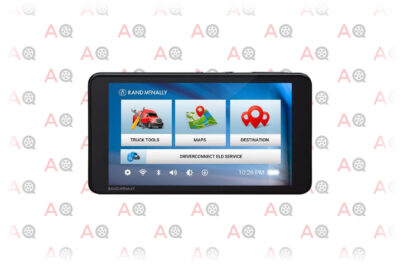
Editor’s Rating:
At a Glance
- Screen Size: 5 inches
- Fleet Management Features: No
- Connectivity: WiFi
Review
One of the least expensive truck-specific GPS devices available from a major manufacturer, the TND 540 LM feels like Rand McNally’s response to the ultra-cheap GPS units that have flooded the market in recent years. The screens of these cheap units are large but low quality, but this device has a small but sensitive screen. While the direct-to-consumer units piggy-back off of GPS networks, the slightly more expensive TND 540 LM relies on Rand McNally’s proven mapping system that includes free lifetime map updates and truck-specific routing.
Also truck-specific? A network of thousands of points of interest, a mapping network that spreads across the entirety of North America, live rerouting based on traffic, and a feature called ‘junction view’ which recommends a lane to drivers when coming up on turns or complex interchanges.
The user interface feels slightly awkward as it was initially designed to be compatible with slightly larger Rand McNally devices like the Rand McNally OverDryve 8 Pro. It’s not a dealbreaker by any means, but icons feel slightly missized and a bit too pushed-together. But defects aside, Rand McNally does an impressive job of cranking out a unit with the features we’ve come to expect that’s priced a bit more on par with the bottom-tier units.
Navigation
Navigation with Rand McNally devices is a mixed bag. While their GPS network is completely accurate in terms of location, sometimes it displays inaccurate speeds. Although more of a user-interface issue than an actual navigation one, the fact that it’s hard to change the size of the map view makes it particularly difficult to understand exactly where you’re supposed to turn, especially in tightly-spaced city environments.
Pros
- An inexpensive response to these common newer units available from cheaper manufacturers
- Truck specific features like POIs and a North America-wide mapping system
- Free lifetime map updates
Cons
- Hard to navigate in urban areas
- User interface is awkward due to small format
6. Best 8-Inch Screen: Rand McNally OverDryve 8 Pro
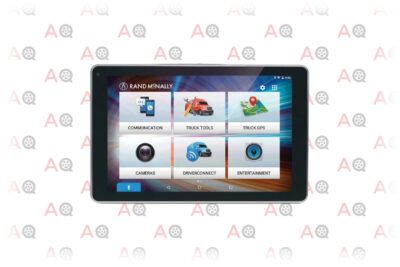
Editor’s Rating:
At a Glance
- Screen Size: 8 inches
- Fleet Management Features: Yes
- Connectivity: Bluetooth
Review
The Rand McNally OverDryve 8 Pro is not an inexpensive unit at almost ten times the price of ultra-budget options like Arova Navigation System. How is that price justified? Primarily with premium features, incredible graphics, and a reliable trucking system. The main issue? Durability, as the last thing you want to worry about on a $500-plus GPS unit is breaking it.
While the price seems outrageous at first glance, remember that if you measure the price by hour used or miles driven, the cost feels a lot more reasonable. Even if it only lasts as long as its one-year warranty (it should work for longer), you’re only paying a little over a buck a day. So it seems fair to say that this unit isn’t necessarily expensive, just that budget units are really, really cheap.
So at the end of the day, if you’re looking for the best of the best and an incredibly sharp screen is important to you, the OverDryve 8 Pro could be a compelling option. Although if you’re looking for a slightly smaller value pick with most of this GPS device’s features, it’s worth it to check out the Garmin Dezl 580 LMT-S.
Navigation
While Rand McNally has had some navigation woes with models like the Rand McNally TND 540 LM, the OverDryve 8 Pro proves that sometimes, you get what you pay for. Navigation is pristinely accurate and the time it takes to lock in and connect is near-instantaneous. The margin of error comes down to just a few feet. If you need near-perfect navigation, pick this unit.
Pros
- Extremely accurate navigation system
- Large, high fidelity screen
- One-year warranty
Cons
- Very high price
- Durability is iffy
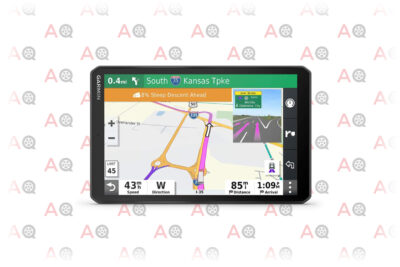
Editor’s Rating:
At a Glance
- Screen Size: 10 inches
- Fleet Management Features: Yes
- Connectivity: Bluetooth and WiFi
Review
Although this device is perhaps the finest and most technologically advanced GPS units on the market, it’s still difficult for many to justify a near $1000 device when there are effective competitors available for under $100.
So what does that extra $900 get you? An iPad-sized screen, for starters, in crystal clear high-def and with both 2D and 3D graphics settings. Also available are Garmin’s custom truck routing (the latest tech in this model), and a full database of loading zones and storage lots.
Hardware is upgraded as well over more expensive units. Garmin sells this unit with a magnetic mount, an industrial-grade suction cup, a ball adapter, and a screw-mount if you need complete security.
The best features, however, and the ones that allow Garmin to command a category-topping price for this unit are the truck-specific ones. Input your truck size and weight information and you’ll get a customized route. Truck-friendly points of interest are available all across the country. Load-to-dock guidance is another proprietary feature that prevents endless driving around the block trying to find the exact load drop off location.
So yes, you get something for your money compared with more economical devices like the Rand McNally TND 540 LM. But is it worth four to ten times the price? That’s a decision you’ll have to make for yourself. For owner-operators, a few extra dollars to have access to loading zones and storage lots can easily pay off over time. For different drivers, especially those who are driving the same routes frequently, a less expensive GPS will get you 95% of the way there.
Navigation
As we’ve already touched on, truck-specific routing for different sizes and weights of trucks is a clear highlight of this unit. Garmin is known for generally quick and accurate navigation, so this unit shouldn’t let you down in terms of routing. Garmin’s network is impeccable as well, meaning signal dropouts will be few and far between.
Pros
- Large format GPS with many truck-specific features
- Industrial-grade mounting options
- Customized routes for truck sizes and weights
- Loading zone and storage lot database
Cons
- Near $1000 price point
8. Best Map Updates: TomTom Trucker 620
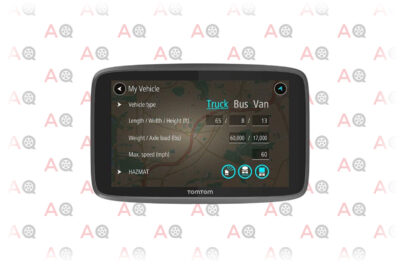
Editor’s Rating:
At a Glance
- Screen Size: 5 inches, 6 inches
- Fleet Management Features: No
- Connectivity: Bluetooth, WiFi
Review
While well-known navigation system manufacturer TomTom offers a proprietary map and navigation system with a small format, it’s a far cry from being as slick as other models equally as expensive. A six-inch touchscreen (there’s also a five-inch option) is comparable with other similar devices, and the TomTom device has other common GPS features like hands-free capability and live traffic.
Although it’s compatible with your smartphone via a mobile app, there’s no Google Assistant integration and no Siri. Truck-specific features include routing that’s purportedly customized on vehicle size, weight, and speed to help keep trips incident-free. Unfortunately, no fleet services either.
Although TomTom claims to adjust routes based on your unique truck info and frequently updated-by-WiFi maps, TomTom often drops the ball on routing, beat out by direct-to-consumer sub $100 products like XGody’s GPS Navigation System. While it’s typically more inconvenient than dangerous, truckers might find themselves on strange backroads when following TomTom routes in rural areas.
Navigation
The biggest fault of this model is navigation. Piggybacking off of TomTom’s standard GPS network and mapping systems, the only addition TomTom adds is a handful of truck-specific features like travel centers and other types of truck-related points of interest. What don’t you get? Weight limits, bridge heights, or gradient info that’s no less than vital for truckers.
Pros
- An inexpensive device with both five and six-inch versions
- Hands-free capability
- Live traffic updating
Cons
- Navigation has limited truck-specific functionality
- So-so routing capability
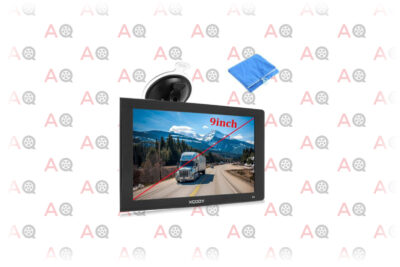
Editor’s Rating:
At a Glance
- Screen Size: 9 inch
- Fleet Management Features: None
- Connectivity: None
Review
With a screen the size of an iPad, a bright LED display, and a loud speaker, your last problem with this GPS device will be missing a turn. Based on inexpensive, lightweight tablet designs, this GPS is easily transportable and includes a suction cup that hangs the system down from the roof of your vehicle and also sets up conventionally on your dashboard.
The similarities with high-end GPS systems like the Garmin Dezl 580 LMT-S stop there, while the purchase of a $500-ish computer gets you specific truck features and an easy-to-use touch screen, a sub $100 GPS makes some sacrifices in the name of price.
The screen? Relatively unresponsive. Truck-specific features? They exist, but this GPS is really a generic map package with an overlaid truck skin that tells you bridge heights without rerouting you, potentially leading to some sticky situations if you don’t pay attention. Still, it’s a heck of a lot better than nothing, especially considering it’s a large-format device with a nine-inch display. If a device like the Garmin Dezl 780 LMT-S GPS is a personal trucking assistant, think of this GPS as an automatically-scrolling road atlas. Not better, not worse, just a bit less comprehensive.
Navigation
While luxury computers offer impeccable coverage, regular updates, and truck-specific info, the XGody GPS Navigation feels like the GPS on a 2010-era smartphone—completely functional, but lackluster. Estimated travel times have a large margin of error, and the signal can drop out at inopportune moments. A savvy trucker will see this as a valuable assistant, but it’s far from a one-way ticket to never thinking about navigation again.
Pros
- Inexpensive GPS with regular updates and full-nation coverage
- More-than-functional GPS
- Some truck-specific features
Cons
- Inopportune signal dropouts
- Travel times have a large margin of error

Editor’s Rating:
At a Glance
- Screen Size: 7 inches
- Fleet Management Features: No
- Connectivity: None
Review
With the same (regularly updated) maps and navigation as premium competitors, a 2D/3D display system, and intelligent route planning, at first glance, it seems like an obvious choice to buy this sub $100 computer over units in the $500 range.
Add a 7-inch capacitive touchscreen and intelligent navigation that adjusts directions based on driving speed, and a low price tag looks even better. But while this GPS navigation system has most of the features of expensive units, it’s the execution, not the features, that make more expensive units more attractive.
For one, battery life: the unit advertises an eight-hour lifetime, but after a few months of regular use, you’ll have to keep it plugged in if you’re looking to keep navigation for longer trips. The connection is an issue too, and the GPS can drop signal annoyingly and randomly. Although the unit uses the same maps as the pricier models, the navigation algorithm is poor and can seemingly randomly send trucks down back roads instead of fast arterial highways. What’s more? There’s neither WiFi nor Bluetooth capacity with this device, meaning that in the case you’d like to connect to a computer, you’ll have to do it with a cable.
Navigation
While OHREX pays for the same, regularly updated maps as premium brands, navigation is touchy. The first issue is signal: the best maps in the world don’t do much good if the GPS can’t figure out where you are currently—connection to the GPS occasionally seems to come and go at will. Routing can be strange as well.
Pros
- 2D/3D display system with intelligent route planning
- 7-inch capacitive touchscreen
- Intelligent navigation system
Cons
- No WiFi or Bluetooth capability
- Poor signal quality
While truck GPS systems range from state of the art to bargain bin, each and every system has the potential to make or break your load. Pick carefully to make sure that your new device will make your trip easier, not harder.
Truckers often require GPS units with features not found in car GPS navigation systems. This means they can take time to get used to and set up properly. Take time to learn your device, as truck GPS navigation devices are so fully featured that you can miss out on important features if you’re not paying attention.
Fleet Services
Since premium Truck GPS Navigation systems like the Garmin Dezl 580 LMT-S]Garmin Dezl 580 LMT-S and Dezl 780 LMT-S GPS have begun to offer fleet services, shipping companies, owner-operators, and even warehouses have begun to take advantage. A couple of the most common features are explained below:
Tracking
Occasionally, manufacturers will incorporate tracking into their GPS devices, which allow stakeholders to track shipments. This isn’t only convenient for dispatchers and shippers, who are now better able to track loads, but access can also be given to clients. Drivers can use this as well for a log of trips. This can prevent fleet managers from needing to buy standalone GPS trackers for their trucks.
Break Planning
With ELD eLog requirements continuously more widespread and enforced, planning breaks require a new level of precision. Many truck GPS systems have FMCSA requirements incorporated into their planning features, automatically suggesting truck-friendly waypoints when a break is required.
Dispatch
Relatively few truck GPS devices come with dispatch connection features, by which dispatchers can track drivers, send messages, and automatically incorporate updated route info.
eLog
Watch for an ELD-ready GPS device that can connect to an FMCSA-registered electronic logging device, making changing duty status and uploading HOS info possible directly from a GPS screen.
Programming
Once you’ve ordered, received, and unpacked your navigation system comes the tricky part: programming. For a truck-specific GPS to function properly, you need to input the proper dimensions and features of your rig so that your device can route you correctly.
To make things easy, make sure you have all the necessary measurements on hand. It’s worth it to put some effort in during set up so you don’t have to worry about the bigger things once you’re ready to get on the road.
Setup
Most GPS devices incorporate some type of mount to attach the device to a dashboard. Some just have a small mount to stick the GPS to the dashboard, others like the XGody GPS Navigation System utilize more elaborate and adjustable suction-cup based mounts that can adjust in all dimensions.
GPS Tips
As with any piece of technology, many users have love-hate relationships with their GPS devices. After all, when you rely on a navigation system for delivering a load and it goes out on you, it can make for a bad day. On the other hand, it was already helping you get there in the first place. The following tips should help things run smoothly:
Familiarization
While many first-time users have the tendency to slap their GPS device up on the dashboard and hit the road, there’s a key step that can’t be ignored if you want a good experience with your GPS device: familiarization. From understanding your GPS system’s menus to getting the right screen angle, we’d recommend taking at least 60 minutes to read your unit’s manual, set up your truck-specific items, and really understand your nav system.
While it’s tempting to drive off and learn by doing, figuring out your GPS while sitting still in the parking lot will pay dividends later. Driving down the interstate with a deadline is not the time to figure out your GPS. It can lead to a wrong turn, or worse.
Troubleshooting
While some GPS difficulties come down to user error, there are plenty of cases (oftentimes in cheaper units) where GPS navigation software or hardware fails on you. And believe it, there’s nothing more annoying.
As with almost all technology, if you’re having issues with your device, the action you can take that’s most likely to solve your problem is a complete system reboot. Sometimes this means unplugging and replugging. In other cases, there’s a button to be pressed. Will it take a few minutes to restart? Yes. Is it worth the time to solve an annoying GPS issue? Absolutely.
Synching
To function properly when your GPS starts up, it has to sync with the global satellite network that allows you to know exactly where you are on the planet down to the meter. It is called a global positioning system, after all. The price of knowing precisely where you are? A small period of GPS synchronization.
While expensive GPS devices can sync almost immediately, cheaper devices like the OHREX GPS Navigator System can take several minutes to sync up. It’s worth it to have a bit of patience, settle in, and wait for your GPS to synch up properly. A good portion of GPS technical difficulties come down to users not taking the time to properly sync their device.
Passive Tracking Features
Almost all of the devices on this list offer some level of passive GPS tracking. This means that your device will track your position, routes, average speeds, and more. Although some drivers elect to opt out of these features, passive tracking can provide helpful data to both trucking companies and owner-operators.
From gas prices, to tracking mileage for tax purposes, to providing information for insurers, passive tracking features can save you time and provide insights into trucking habits. It’s worth it to look into exactly what your device offers.
Using Standard Consumer GPS Devices
Is it possible to use a standard GPS device as a trucker? Yes, and there are truckers, companies, and owner-operators that use standard devices meant for cars when driving. However, considering the high stakes of truck load delivery, it’s more than worth it, at least for most truckers, to purchase a unit that has some protection against the risk of heading down a route where trucks aren’t permitted or worse, won’t fit.
FAQs
How Will a GPS Navigation System Help With eLog Compliance?
In December 2017, ELD eLog ‘electronic logs’ were implemented into the trucking industry, requiring new, stricter standards for accuracy and completion of truck logs. These logs are maintained by FMCSA-registered electronic logging devices that monitor breaks and durations of trips. While there aren’t any truck-specific GPS navigation devices that actually function as FMCSA-registered electronic logging devices, some GPS displays can be connected with eLog devices, making changing duty status and HOS info easy and automatic.
Can I Set Routes Based on Cargo?
The trucking industry is all about planning, and a huge part of that is making sure the right freight gets on the right route. From hazmat loads, to temperature-sensitive loads, to loads that need to bypass certain states, life is easier if your GPS takes care of it. For the most part, only higher-end GPS devices will be able to program routes based on cargo.
How Do I Troubleshoot My GPS?
While high-end GPS devices like the Garmin Dezl 580 LMT-S claim to work on any point on the planet, some GPS networks and devices can be a little more lackluster. Nonetheless, the advice for most electronics holds true: restart, disconnect, reset, and, if you still can’t work it out, contact customer support (TomTom has a fantastic customer support line).
Most people don’t put too much thought into their navigation systems, they just plug in the destination and take off. While most of the time, it’s that simple, different systems give different routes, report different traffic conditions, and offer varying degrees of accuracy based on their programming. Oftentimes, bigger companies with bigger reputations are worth the extra price based on the effort they put into maintaining their networks.
Frequency of Updates
Roads are being built, repaired, narrowed, and widened on a constant basis. This affects traffic, distances, speeds, and if you can even get to your destination in the first place. While companies like Garmin issue frequent updates every three to four months, other manufacturers take years to re-update their maps. Others still piggyback off of third-party systems and thus don’t have much control over mapping systems, or worse yet, have to pay a larger company for updates.
Live Features
Mobile application makers like Google Maps and Waze use their network of mobile devices to read live traffic conditions and make routing decisions to help you get to your destination as quickly as possible. While bigger GPS manufacturers can reroute you based on live traffic inputs, other manufacturers don’t have the capacity or density of devices to provide live updates.
If you’re frequently trucking around high-density areas, it’s worth it to look into a device with live updates, but if you are mostly doing long highway miles, a device that reroutes based on traffic may not make much of a difference.
Access to Maintenance Reports
Truck GPS Navigation systems like the Garmin Dezl 780 and the Garmin 580 offer a high level of integration by plugging directly into the truck, giving feedback and alerting you of scheduled maintenance and eLog intervals. These are particularly valuable for those who use a fleet vehicle or for drivers that put huge miles on their trucks.
GPS navigation systems experienced a major heyday in the early 2000s, as smartphones took over general GPS apps. Eventually, truck-specific GPS apps began to gain market share against dedicated GPS navigation systems. While GPS apps have their place, many truckers still use and prefer a hardware-based GPS.
With the low cost and high accessibility of phone apps, truckers and trucking companies are sometimes hesitant to buy expensive GPS navigation devices. While the cost of a specific device isn’t insignificant, there are some distinct benefits that a GPS navigation system adds.
Reliability
With a cell phone, your fate is up to your phone battery and your service provider. An effective GPS works 100% of the time, in any spot on earth. Plus, as long as your truck is running, you’ve got the power to run your GPS.
Fleet Management
Apps don’t have fleet management integrations like truck-specific GPS navigation systems, which means they don’t offer the same organizational benefits. This means, among other things, no fleet tracking, no speed tracking, no route planning features, and definitely no access to maintenance reports.
Truck Specific Info
Most apps don’t offer the information that truckers find vital: road conditions, speed limits, truck-specific hazards like weight limits and bridge height limits, weigh stations, and other truck-specific information. GPS Navigation units? A totally different story.
Legality
An unfriendly police officer and messing with an uncooperative cell phone while driving can lead to a broken law, a pricey ticket, or even a license suspension. Avoid the problems before they happen by using a hands-free, voice-control GPS device.
There are a few great truck-specific GPS apps to use, although most have at least some drawbacks compared to a dedicated system. The benefit, however, is cost, and apps cost a fraction of the price of a permanently mounted system.
- CoPilot Mobile Navigation for Trucks: CoPilot Mobile Navigation is a dedicated system for trucks that installs on both Android and Apple devices. With fleet services, truck-specific routing, and offline capabilities, it’s the closest thing to a dedicated GPS, although it functions best on a tablet-style device (read: expensive), and a subscription model means that over time, it might not be cost-effective.
- Sygic Truck Navigation: Popular abroad but now making its way into the domestic market, Sygic Truck Navigation is a relatively inexpensive truck-specific app with offline maps, but it relies on Google Maps for all routing. You’ll also have to buy your own devices to control routing.
- Google Maps: Plenty of truckers like to use the ultra-convenient Google Maps to plot their driving routes, and although the app is free and provides accurate traffic information, it lacks truck-specific routes, fleet management services, and requires a data connection.
Wrapping Up
Experienced truckers are the most likely to have a tricked-out, custom cabin with all the latest technology, and for good reason: they know that keeping equipment up-to-date can be tremendously effective in terms of saving time and money.
Whether you’re an independent trucker or you control a whole fleet, a good truck GPS navigation system can be the difference between running a profit and losing money in this ultra-competitive industry. Effective shopping can mean the difference between a smooth trip and a lost load.


